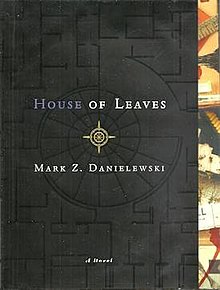House of Leaves

First-edition cover
|
|
| Author | Mark Z. Danielewski |
|---|---|
| Country | United States |
| Genre |
Horror Romance Satire Postmodernism |
| Publisher | Pantheon, Random House |
|
Publication date
|
March 7, 2000 |
| Media type | Print (paperback and hardcover) |
| Pages | 709 (paperback) |
| ISBN | |
| Followed by | The Whalestoe Letters |
House of Leaves is the debut novel by American author Mark Z. Danielewski, published in March 2000 by Pantheon Books. A bestseller, it has been translated into a number of languages, and is followed by a companion piece, The Whalestoe Letters.
The format and structure of House of Leaves is unconventional, with unusual page layout and style, making it a prime example of ergodic literature. It contains copious footnotes, many of which contain footnotes themselves, including references to fictional books, films or articles. Some pages contain only a few words or lines of text, arranged in strange ways to mirror the events in the story, often creating both an agoraphobic and a claustrophobic effect. The novel is also distinctive for its multiple narrators, who interact with each other in elaborate and disorienting ways.
While some have attempted to describe the book as a horror story, many readers, as well as the author, define the book as a love story. Danielewski expands on this point in an interview: "I had one woman come up to me in a bookstore and say, 'You know, everyone told me it was a horror book, but when I finished it, I realized that it was a love story.' And she's absolutely right. In some ways, genre is a marketing tool."House of Leaves has also been described as a "satire of academic criticism."
House of Leaves begins with a first-person narrative by Johnny Truant, a Los Angeles tattoo parlor employee and professed unreliable narrator. Truant is searching for a new apartment when his friend Lude tells him about the apartment of the recently deceased Zampanò, a blind, elderly man who lived in Lude's apartment building.
In Zampanò's apartment, Truant discovers a manuscript written by Zampanò that turns out to be an academic study of a documentary film called The Navidson Record, though Truant says he can find no evidence that the film or its subjects ever existed.
...
Wikipedia
